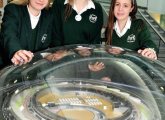Dr Joanna Rhodes has some great suggestions for activities to help students understand the chemistry of colour…
Today you will…
- Investigate the chemical properties and possibilities of colour
We start the lesson with a photograph of my wardrobe with the doors open and all of my clothes hanging neatly together. Wearing bright clothes in the classroom is a preference of mine so there are reds, blues, purples and greens. But, I ask the students, if I close the doors and it is completely dark inside the wardrobe, are the clothes still coloured? During the course of the lesson the spectacular chemistry of colour will provide us with a surprising answer.
During this vibrant lesson students will learn about why substances have colour and will create their own dyes, perform experiments with colorimetry and chromatography, and learn about the way chemistry is playing a huge role in the art world by creating their own mini episode of fake or fortune. Students will learn about the heritage of colour in the UK chemical industry as well as developing strong cross-curricular links with art and history.
Starter activity
Colour and Light
In this thought provoking starter activity, give students a variety of brightly coloured everyday objects. In the white light of the classroom these coloured objects all appear ‘normal’. Ask students to investigate the colour they appear when viewed through different coloured filters using a light box [Additional Resource 1]. If you view a red object with a red filter what colour does it appear? What if you view it through a blue filter? This starter activity allows you to introduce students to the reason objects have colour. Chemicals within the object absorb light of specific frequencies and reflect all the other frequencies back to the eye. It is these frequencies that we see. Ask students to think about the dark wardrobe again. Without any light do the clothes possess any colour?
Main activities
1. Chromatography and the chemistry of autumn
If an object is made with the right chemicals it can appear any colour we want. In this practical students investigate mixtures of different coloured chemicals used in pen inks and coloured sweets with paper chromatography [AR2]. Provide students with prepared rectangles of filter paper and ask them to draw a pencil line 2cm from the bottom. On this line they place a small dot of the dye, ink or food colouring they are investigating. If testing sweets such as Smarties®, M&Ms® or Skittles® the coloured dye can be rubbed off with a cotton bud and blotted onto the paper. Then suspend the paper vertically in about 1cm depth of water or ethanol (if available). As the solvent travels through the paper the dyes are separated into the different components of the mixture. The process works for synthetic and natural dyes and could also be used with fruits such as blackberries or blueberries. A really interesting variation of this practical is to use chromatography to investigate the different coloured pigments in leaves [AR3]. Students can use their discoveries to explain the colours of leaves we see in autumn. When the tree stops synthesizing new green chlorophyll (a molecule that absorbs red light) it decomposes to leave yellow carotenes (molecules that absorb blue light) and red anthocyanins (molecules that absorb green light).
2. Concentrating on colour
Transition metals often form coloured compounds. Copper is known for forming blue compounds, nickel forms green compounds and metals such as manganese, chromium and vanadium have many oxidation states each with characteristic blues, purples, yellows and greens. Students can use a technique called colorimetry to determine the concentration of any of these compounds in solution, as the amount of light absorbed by the sample is directly proportional to the concentration of the chemical.
Colorimeters are relatively inexpensive but if your school does not own one then why not arrange to use a UV/Visible Spectrometer on loan from the Royal Society of Chemistry through the Spectroscopy in a Suitcase scheme [AR4]? With either piece of equipment students should begin by producing a range of standard solutions [AR5]. This technique is also useful when preparing to do a titration and can be used to improve understanding of solutions and molar concentration. By taking readings from the colorimeter across their range of solutions (for example 0.1 to 1.0M) they can plot a calibration curve for that substance. You can then provide students with a range of ‘unknowns’ that they can test for concentration.
Summary
Fake or fortune?
Chemistry plays a very important part in determining whether a painting is a genuine or not. Old pigments such as those based on mercury (vermillion) and arsenic (emerald green) are considered too dangerous to be used today and their presence in a painting can suggest its age. New pigments such as titanium white are clear evidence of a modern painting. In this activity students are part of a forensic team working on a high profile forgery case. They have to determine whether the painting in question is the real thing by using flame tests on samples from the blue regions of the painting [AR6]. If the painting were genuine we would expect to find copper pigment, which burns bright blue in a Bunsen flame. For the tests give students three small samples. Label one tiny sample as from the painting and then provide a sample of powdered copper carbonate (azurite) and synthetic ultramarine as the controls. Ultramarine contains sodium and burns with a yellow flame. It is up to you whether students discover the painting is a fake or a fortune!
Home learning
1. Web quest on the dye industry
Indigo is one of the oldest dyes. Its natural form was known in Mesopotamia, Ancient Egypt and Greece. Dyes were very expensive and some were derived from precious materials like the stone lapis lazuli. Things changed however when in Britain’s industrial heartlands of West Yorkshire my local town, Huddersfield, became a global hub for the creation of synthetic dyes for textiles vastly reducing cost and allowing bright and vibrant clothes to be available to the masses. In this web quest students investigate the development of natural and synthetic dyes and present their work as a PowerPoint presentation or poster.
2. Colour Uncovered
Ask students to download and install this free app [AR9], produced by explOratorium. Colour Uncovered is an interactive book for the iPad where students can explore colour phenomena and optical illusions such as “when yellow is yellower than yellow” and why you would not want your dog to drive.
About our expert
Dr Joanna L. Rhodes M.Chem, D.Phil, MRSC is a teacher of science at Shelley College, Huddersfield.
Stretch them further
Synthetic indigo
An inspiring introduction to a-level chemistry techniques can be found in the microscale synthesis of indigo dye [ar7]. this straightforward practical from the royal society of chemistry produces a good quality sample of indigo that can be used to tie-dye a handkerchief or t-shirt if all the samples are pooled together. this can be contrasted with natural dyes [ar8] obtained by boiling red cabbage, onion skins, carrots or rose-hips. encourage students to blend chemistry with creativity in the lab.
About our expert
Dr Joanna L. Rhodes M.Chem, D.Phil, MRSC is a teacher of science at Shelley College, Huddersfield.
Additional resources
[1] Light and colour tinyurl.com/tscolour1
[2] Chromatography of sweets tinyurl.com/tscolour2
[3] Chromatography of leaves tinyurl.com/tscolour3
[4] Spectrocsopy in a suitcase tinyurl.com/tscolour4
[5] Making standard solutions tinyurl.com/tscolour5
[6] Flame test method tinyurl.com/tscolour6
[7] Microscale synthesis of indigo dye tinyurl.com/tscolour7
[8] Natural History Museum natural dyes tinyurl.com/tscolour8
[9] Colour Exploratorium tinyurl.com/tscolour9










Dr Joanna Rhodes has some great suggestions for activities to help students understand the chemistry of colour…